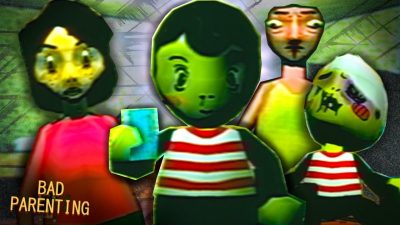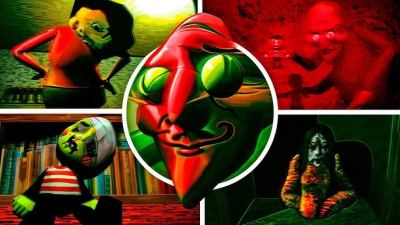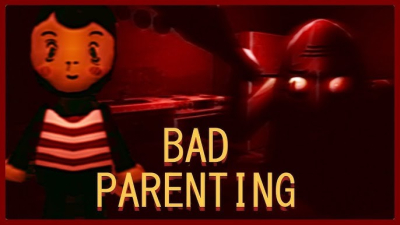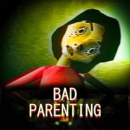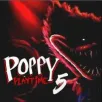Bad Parenting
I recently decided to immerse myself in the universe of Bad Parenting 1: Mr. Red Face and found myself grappling with a sense of both intrigue and shock. Coming from a background of more conventional titles, I was initially skeptical about embarking on a journey that promised a blend of unconventional humor, outlandish situations, and challenging scenarios centered around the theme of parenting gone awry. As I started the game, I couldn’t help but reflect on how this experience might contrast sharply with everything else I had encountered in the gaming world. The game's title, evocative yet mysterious, gave an early hint of the absurd narrative fabric interwoven with moments of raw emotional tension and playful mischief. Each stage presented a fresh challenge that quickly cemented its presence in my daily gaming conversations.
Immersing in the Mechanics of Mayhem
The core gameplay mechanics of Bad Parenting 1: Mr. Red Face are robust, offering a variety of scenarios that test my strategic thinking and reflexes. Navigating through environments filled with unpredictability required me to manage resources, time events effectively, and plan my actions with utmost care. At first glance, the mechanics appeared to draw inspiration from classic management simulations, but they quickly evolved into a more layered experience that demanded constant adaptation. The idea of balancing humor with high-stakes decisions was particularly appealing, as it blended the everyday trials of parenting with a surreal twist. I found that each decision mattered significantly, impacting subsequent challenges and even how certain characters reacted later in the game.
Savoring an Eccentric Narrative
What struck me the most about the game was its narrative, which is as quirky as it is thought-provoking. The storyline centers on a character who juggles complex parental responsibilities while contending with a series of puzzling predicaments. For me, this narrative was much more than a simple tale of misadventures. It was a deep exploration of human fallibility, societal expectations, and the intricate dance of balancing personal shortcomings with responsibilities. I was drawn into the character’s internal conflicts, as the game does not shy away from presenting the imperfections inherent in every human experience. In moments of high tension, the absurdity of the predicaments brought a kind of morbid humor that kept me grinning even as I navigated through the chaos.
Engaging with a Rich and Varied Environment
As I wandered through the diverse areas of the game world, the setting proved to be a character in its own right. Whether I was exploring chaotic neighborhoods, quaint suburban settings, or even surreal dream-like environments that defied logic, each location was crafted with meticulous attention to detail. The environments are more than just backdrops to the narrative; they reinforce the whimsical yet dark tone of the game. I particularly enjoyed the contrast between the mundane details of everyday life and the unexpected bursts of hilarity and distress, providing visual punctuation to the game’s narrative rhythm. Every setting felt deliberate and evocative, weaving together a tapestry that captured both the beauty and the irony inherent in the challenges of parenting under unusual circumstances.
Listening to a Soundtrack of Emotions
The sound design in Bad Parenting 1: Mr. Red Face plays a significant role in enhancing the overall experience. I was pleasantly surprised by the eclectic mix of sound effects, voice acting, and ambient music that altogether created a resonant audio landscape. The music shifted elegantly between playful, upbeat compositions and more somber, reflective pieces, mirroring the game’s fluctuating tonal shifts. Sound effects were carefully synchronized with the gameplay, deepening the immersion and emphasizing moments of both tension and comic relief. Whether it was the sharp, abrupt noises during a chaotic scenario or the gentle background melodies that underscored quieter moments, the audio truly amplified the emotional core of each experience.
Admiring Bold Visuals and Artistic Choices
Visually, the game struck me as a vibrant fusion of cartoonish style and gritty realism. The artistic direction, characterized by bold colors and exaggerated character designs, captures the whimsical yet challenging nature of the narrative without veering into caricature. I found myself repeatedly pausing to appreciate the intricacies of the character animations and the dynamic interplay between light and shadow that adds depth to every scene. The color palette, chosen with both care and audacity, supports the thematic elements of unpredictability and chaos while maintaining a visually coherent experience. Every detail, from the smallest background element to the major character expressions, contributed to a unique aesthetic that felt both fresh and nostalgically familiar.
Commanding Interfaces and Responsive Controls
When it comes to interactivity, I experienced first-hand the well-thought-out interface and control scheme of the game. The user interface is designed to be intuitive yet layered, offering both guidance and freedom. Navigating various menus, handling in-game items, and making quick decisions during unexpected events were all seamlessly integrated into the gameplay. I appreciated the responsive controls that ensured my actions translated immediately to on-screen events, a crucial factor given the game’s reliance on timing and strategy. The blend of mouse and keyboard (or controller) support made the game accessible across a range of devices, ultimately enhancing the overall experience by reducing friction and allowing a smooth transition between the story and gameplay.
Unraveling the Threads of Humorous Absurdity
One aspect that consistently stood out for me was the humor, which is both dark and absurd. The narrative weaves moments of unexpected comedy amidst the tension and intricate challenges. I laughed out loud at several instances where the absurdity of the situations overcame the inherent drama, showcasing a talent for balancing seemingly conflicting emotional beats. The humor is not forced; instead, it emerges naturally out of the interactions between characters and the unfolding of events. This well-calibrated mix of seriousness and levity left me with a memorable impression, highlighting the game’s ability to take risks and challenge conventional storytelling in video games.
Diving Deep into Character Development
As I progressed further into the game, I became particularly drawn to the intricate development of its characters. The protagonist’s struggles, charged with both humor and vulnerability, provided a refreshing twist on what might initially appear to be a lighthearted theme. Interactions between the characters were imbued with subtle layers of emotion and meaning, transforming simple dialogues into explorations of personal identity and responsibility. I felt connected to the character’s inner turmoil and occasional moments of triumph, which were conveyed through expertly written dialogue and nuanced animations. Every encounter offered a glimpse into the character's psyche, and the gradual unfolding of their inner world was an experience that I cherished, apprehending the profound implications behind every seemingly trivial decision.
Designing Experiences Around Uncertainty
The unpredictable nature of the game compelled me to rethink my approach to challenges. The mechanics revolve around embracing uncertainty, which initially felt disconcerting but grew to be one of the most engaging aspects of the title. Instead of following a predetermined path, I was continuously presented with scenarios that required dynamic adaptation. This responsive design did more than just test my problem-solving abilities—it also pushed me to appreciate the beauty of unpredictability. The challenges in Bad Parenting 1: Mr. Red Face demand that I stay present, constantly assess the situation, and rely on quick thinking. I admired how the game celebrated the journey through uncertainty rather than solely rewarding successful outcomes, making each playthrough a truly individual adventure.
Capturing Intricate Layers of Strategy
This game is not merely a sequence of comedic vignettes; it also embodies a strategic depth that I found captivating. Every element, whether it be planning daily routines or managing unexpected events, is interconnected to the broader gameplay experience. As I navigated this challenging environment, I was required to evaluate risk, prioritize tasks, and sometimes even trade short-term gains for long-term stability. I found the balance between strategy and spontaneity particularly rewarding. The game insists on thoughtful consideration before taking action, and each misstep often fed back into the overall narrative, creating a cycle where every decision carried significant weight. I began to appreciate this emphasis on calculated decision-making as a means to truly explore the game’s myriad possibilities.
Exploring Player-Driven Customization and Interactivity
Another layer of appeal in Bad Parenting 1: Mr. Red Face comes from its flexibility in customization and interactivity. I was intrigued by the level of personalization available, from tweaking the character's appearance to adjusting gameplay elements that allowed me to tailor the experience to my taste. This customization extended to various aspects of gameplay, enabling me to experiment with different strategies and methods of approaching challenges. The game also encourages interactive problem-solving, sometimes even inviting community participation as I explored forums and guides discussing various in-game strategies. The flexibility in approach provided a refreshing sense of empowerment, as I was not confined to a single method of interacting with the world. Instead, I was free to adjust the game mechanics and narrative flow according to my creative preferences.
Relishing the Interplay Between Simulated Chaos and Order
The juxtaposition of simulated chaos and underlying order in Bad Parenting 1: Mr. Red Face is something I found particularly evocative. While the game revels in showcasing the craziness inherent in its premise, it equally emphasizes that even the most unpredictable scenarios operate within their own set of intricate rules. I was fascinated by how the developers introduced a calculated structure beneath the surface of apparent disorder. The design demonstrated that every chaotic moment, no matter how absurd, was balanced by a rationale that governed every event. As I continued to navigate through this world, I began to notice that embracing the chaos was, in itself, a carefully orchestrated challenge that invited players to find order amid tumult—a duality that consistently elevated my engagement with the narrative.
Experiencing a Symphony of Emotional Contrasts
From the very start, I was drawn into an emotional landscape that oscillates between mirth and sorrow, a characteristic quality of the game. I found that every challenge, every humorous moment, and every dramatic twist resonated deeply with the underlying sentiment of imperfection prevalent in human experiences. The emotional contrasts were engineered meticulously, enabling me to experience a roller coaster of feelings that ranged from elation to introspection. Every moment, whether filled with playful banter or poignant reflection, served as an invitation to examine the multifaceted nature of responsibility. This emotional journey was a reminder that the narrative is as much about the internal struggles of its characters as it is about the external antics they encounter, and it allowed me to deeply empathize with their follies and triumphs.
Relating to the Nuances of Everyday Chaos
The familiarity of everyday chaos is at the heart of my experience with Bad Parenting 1: Mr. Red Face. While the game places me amidst surreal and exaggerated situations, its underlying theme is unmistakably drawn from the complexities of real-life parenting scenarios. I found that the game reflects the unpredictable nature of daily life in a way that resonates with anyone who has ever tried to manage multiple responsibilities at once. The nuances of everyday chaos—unexpected mishaps, humorous misunderstandings, and the balancing act between duty and desire—are portrayed with such authenticity that I often caught myself reflecting on my own experiences. The blend of relatable challenges and outlandish storytelling lifted the game from mere entertainment to a mirror that reflects the messy, genuine nature of life, inviting me to laugh at its inconsistencies while recognizing the underlying truths.
